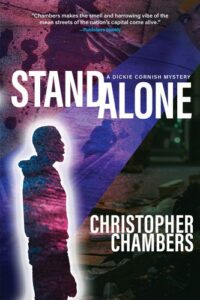I hadn’t planned a deep-dive essay. Just a brief think piece…maybe a couple of examples where the gravamen of the story is not cat-and-mouse with an evil nemesis…no one’s menacing their husband’s mistress at a beach house…the mastermind of heist gone-wrong isn’t being double-crossed.
Yet two things happened. First, I started interviewing friend and colleagues in crime writing—from newbies and true crime journalists to reliable list-toppers to studio favorites— and found that all had a lot to say, and much of it would ruffle and rattle. So ruffling and rattling in fact that a few said they didn’t want to be identified. Second, recently on HBO, home of David Simon’s masterpieces The Corner and The Wire, and author George Pelecanos’s The Deuce and cop drama We Own These Streets, a stream-of-consciousness critique of crime/cop/mystery dramas gushed from an unlikely source: Daily Show alum John Oliver’s This Week Tonight. And though Oliver’s segments are comedy-satire bits…he even mentioned author Linda Fairstein and the “Central Park Five.”
Oliver’s screed-of-the-week posited Dick Wolf and his Law and Order franchise as a metaphor for police propaganda and white-wash of what is a sausage-machine criminal justice system, fed by fatalism and poverty, whether the fodder’s from an urban street corner or a rural crossroads. Through old quotes from Wolf himself, former showrunner Warren Leight, and even clips of SVU heroes “Olivia Benson” and “Elliot Stabler,” Oliver paints a duality of utter fantasy versus an awful reality. The “real” SVU at times had a closure rate of 6%, and its officers were accused of bullying or discounting victims. Nettlesome George Floyd/Breonna Taylor matters, racist or sexist command staffs, even old-school Serpico corruption, were handled with melodramatic morality plays where the blue-clad bad-apples got their comeuppance, and the virtuous heroes rallied. Perps were white people because, in Wolf’s words, white people, particularly males, don’t have an “interest group” that can “protest” how they are portrayed. Victims, too, fit a profile. From that cynical notion came an even more cynical, ironic allegory: that to the target audience…it was more compelling “must-see TV” to view reflections of themselves as plucky or downtrodden victims who rise…and more entertaining to see people like themselves who’d become twisted, then do evil, then have a hero, flawed yet stalwart battle these evildoers until a final denouement. As Warren Leight observed, it’s hard to pitch “Innocence Project”-related shows, or of a community of attempting to rise despite police abuse or poverty, against the sheer mass and gravitation of that formula.
Sufficiently startled by Oliver’s segment, I put the issue to hardboiled maestro and co-editor of South Central Noir Gary Phillips. His first cut was craft-oriented: “street crime” as a plot-driver is rare beyond a backdrop or a conduit a headier monster because it’s tougher to engineer a sustainable story about something constant, impulsive, fleeting, incongruously anonymous yet intimate. Likewise, Tracy Clark, award-winning author of Runner and Borrowed Time offers, “I think street crime doesn’t get a lot of fiction love because it’s not glitzy or clever or inherently puzzle-worthy enough. It’s not espionage or a high-level corporate raid. It’s just crime, crime that’s often senseless, dirty, irrational, random and most times painfully tragic. As readers, we kind of want a satisfying wrap up at the end of a book, don’t we? We want Hannibal Lecter locked up. We want the poisoner at the tea party to get caught. We want the hero to figure it all out and tie the case up with a pretty red bow.”
Yet Phillips and Clark also declare that craft difficulty is no excuse. Phillips asserts it the crime author’s obligation to push the envelope and “educate”—not the just the readers but agents, publishers, other authors if need be. And as Clark states, “[a] 14-year-old who shoots a senior citizen for her Social Security check is a societal failure, a human failure. We can play the blame game all day, but the bottom line is that crime on the community level, on the streets, is brutal, jarring, and unforgiving. We can all be at the wrong place at the wrong time and fall victim.” Agreeing with Phillips she adds, “What motivates a driveby shooter? What makes a gangbanger? Who is responsible for a 15-year-old with a gun? Street crime hits home. It grabs us at the city, neighborhood, family level. It scars us where we live, it threatens those we love. I can’t think of anything more powerful to explore in a crime novel.” (Emphasis supplied).
Todd Robinson and Michael A. Gonzales come at it from another angle, that of experience honing the artform. Robinson, former editor of THUGLIT, “noir at the bar” impresario, and whose many hardboiled novels include Rough Trade and The Hard Bounce opines, “I think the disconnect is in tolerance. Street level is nasty, dirty. Done right, you should be able to smell the piss on the subway, feel the grime clogged under your fingernails.” That’s perhaps more achievable on film or TV, as he thinks, “ [i]t’s more palatable for an audience to spend two hours in that world than 300-plus pages.” Nevertheless, those bugbears, sociology and demographics, seep back into the analysis. “[M]ystery readers, by and large, are older, don’t live in these areas anymore. They seem to dig into a fantasy of crime where violence doesn’t hurt, where death is an inconvenient puzzle to be solved. But me? Give me the dirt, baby.”
Gonzales, a frequent CrimeReads contributor, culture critic, former editor of VIBE and short fiction contributor to Under the Thumb: Stories of Police Oppression edited by S.A. Cosby, recounts how street crime has always been more than a backdrop to his reporting and fiction writing. “I grew up in Harlem, before gentrification. And street crime it affected us every day, if not directly then because every family had someone, or someone connected to someone, connected to that life, as a criminal, or as a victim.” He prompts the memory of his blood brother of the pen, the late Jerry Rodriguez. Rodriguez’s nuyorican detective fiction in Devil’s Mambo and Revenge Tango remains an exemplar of cut-to-the-bone crime fiction writing where intimate knowledge and observation allowed even the pettiest or most ugly “street crime” to carry a novel-length story—and win critical fame. I recall attending an event Rodriguez headlined in Brooklyn many years ago. At the bar with Gonzales and myself, he presaged the creed propounded by Gary Phillips, Tracy Clark and Todd Robinson: that stories based solely on hardscrabble existence should hold a crucial place in our genre, considering the real-life toll taken, real-life issues feeding it. Yet while critics were awakening to this vision—as many were “rediscovering” the pulpy force of Chester Himes, Iceberg Slim and Donald Goines— Rodriguez wondered aloud whether a broader public would ever take notice?
As stated above, a few sources did not wish to be identified for this piece. Discount their views accordingly but keep this in mind: this is an essay, not a news feature. Thus I invited you to parse them here, as they are no less discomfiting than Oliver’s screed, and are just as triggering as Jerry Rodriguez’s now twenty-year-old question.
“You don’t see this [street crime] for the same reason millions discussed a spider on Queen Elizabeth’s casket yet had no clue about the destruction on Puerto Rico. We are in the escape business. Reality is uncomfortable. Especially if it involves ‘the other’ in terms of class and race. The typical mystery/thriller reviewer on Amazon or Goodreads doesn’t come from ‘the other,’ nor do most publishers’ staffs.” Other opinions coalesced around content like The Wire and its central theme: our “War on Drugs” wasn’t bringing victory, just generational casualties, bursting prisons and a jaded police force. “That remains cognitive dissonance for big segments of the American population.” The disconnect might explain the show’s poor ratings compared its HBO cousins Sex and the City, or mob fable The Sopranos. Another source reminded me many viewers ignored David Simon’s Homicide, Life on the Street—which also featured Baltimore cops coming to grips with the nihilism, fatalism and desperation of street crime and drug abuse—in favor of the melodramatic NYPD Blue, which featured action, dueling egos and squad room romance. Another observed, “A theme in Ryan Murphy/Netflix Jeffrey Dahmer series Monster is indifferent policing and white privilege’s benefit of the doubt that may have kept the killer unchecked. “It wasn’t cunning detective work by a selfless hero that stopped the butchery of gay men, men of color. It was brave souls who refused to be victims. Somehow that still doesn’t fit the happy endings much of the public and gatekeepers demand for fiction content.” This source’s final blunt assessment: “Stories based on street crime are seen as ‘niche.’”
Of course, whether it’s niche or outright ignored, there are and were writers and creators injecting bleak “everyday” reality into their crime stories. Grace Edwards was doing it with hoodlums in Harlem long ago and laid a foundation for contemporary daughters in the hardboiled craft like Tracy Clark, above, or Nikki Dolson, Cheryl Head, Wanda Morris, Delia Pitts, Faye Snowden. Joseph Wambaugh’s first novels featured only the nervous itch in a squad car as it rolled through a prurient patrol route, and this, in turn, inspired writers like Bruce Robert Coffin, Mark Bergin or James L’Etoile. Before the protagonists engineered by Laura Lippman, Reed Farrell Coleman, Gar Anthony Haywood, George Pelecanos, Sue Grafton, Sara Paretsky tackled pattern killers or drug kingpins, or dismantled sophisticated capers, they were measured and tested by the mala in se and mala prohibita of the street. Steph Cha used these crimes to measure and test the thin strands that hold society together; writers like James Hannah or Jordan Harper and of course S.A. Cosby use the hinterland version of such bad acts, petty or otherwise, to measure and test the thin strands that hold a human soul together.
Actor Aiden Guillen, “Littlefinger” of Game of Thrones fame after cutting his HBO teeth on The Wire’s “Mayor Carcetti” once owed The Wire’s popular, not just critical, purchase in Ireland to the island’s troubled history, wealth disparities, noir infused in every brick. In that vein, Professor Anjili Babbar, President of the Dashiell Hammett Society, describes how contemporary Irish crime writers are particularly adept at including everyday crimes in their work: the neighborhood scuffles and unrest, the local shootings, the deaths that don’t make the news. “In this way, they remind us of the real people who are affected by shortcomings in the justice system, whose stories might otherwise get lost in our analytic discourse about justice with a capital J.”
Babbar’s example echoes Hollywood showrunner Jacque Cofer’s examples on cable, most notably Snowfall on FX, Michael B. Jordan and Courtney Vance’s 61st St. on AMC, the Power franchise and notably Power: Kanan on Starz and early seasons of The Chi. “All have a larger drug gang narrative but deal with the ramifications of street crime (chain snatching, gun violence) on real young people and their families. Again, they are usually part of the larger crime story the series is telling but these smaller contributory story lines are no less poignant and compelling.”
So in the end it all comes back to telling a good story? That’s the cliché. Perhaps the reality about the reality of “street crime” might thus be factored or reduced to this: Do your homework, swallow hard, then convey the story honestly, with the desperation, petty motivations and horrific consequences in plain view. Convey it, even if you think no one will watch or read it.
Now you can turn the page or reach for the remote…
***


















